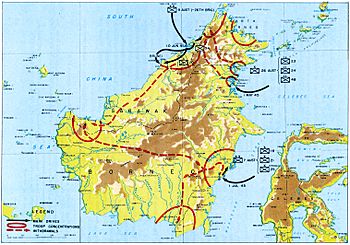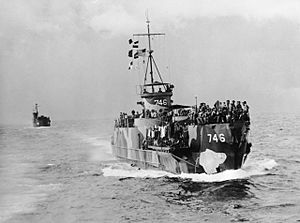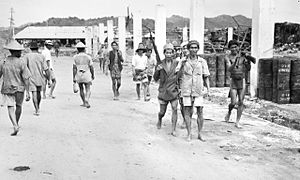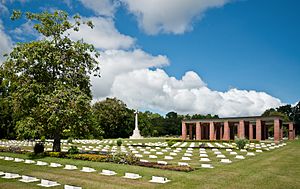Borneo campaign facts for kids
Quick facts for kids Borneo campaign |
|||||||
|---|---|---|---|---|---|---|---|
| Part of South West Pacific theatre of World War II | |||||||
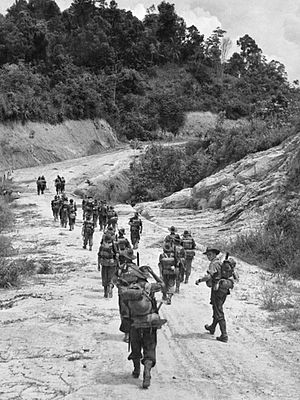 Australian troops advancing towards Brunei |
|||||||
|
|||||||
| Belligerents | |||||||
| Allies: |
|||||||
| Commanders and leaders | |||||||
| Strength | |||||||
| c. 74,000 | 32,000 | ||||||
| Casualties and losses | |||||||
| 2,100 casualties | 4,700 casualties | ||||||
The Borneo campaign was the last big military action by the Allies in the South West Pacific Area during World War II. It aimed to free Borneo, an island that was held by Japan since late 1941. This campaign was also known as Operation Oboe.
From May to July 1945, Australian soldiers led a series of amphibious assaults (landings from the sea). They were supported by air and naval forces from the United States and other Allied countries. The main Japanese forces on the island were led by Lieutenant-General Masao Baba and Vice-Admiral Michiaki Kamada.
The campaign had landings at four main places: Tarakan, Labuan, North Borneo, and Balikpapan. Local Dayak tribesmen and a few Allied soldiers also fought as guerrillas inside the island. Most of the fighting ended by mid-July, but small battles continued until the war finished in August.
The Allies hoped to capture airfields and ports to help with future operations. However, the heavy bombing before the landings caused a lot of damage to the island's buildings and oil fields. This meant the Allies didn't get as much benefit from the campaign as they had hoped.
Contents
Why Was Borneo Important?
Before World War II, Borneo was split into British and Dutch parts. It was a very important place because of its oil fields and other natural resources. The island's location was also key, as it sat on major sea routes.
Despite its importance, Borneo was not very developed. It had few roads and only one railway. Most travel happened by water or small paths. The British and Dutch had only small military forces there.
Japan quickly took over Borneo in late 1941 and early 1942. They wanted to control the oil fields and protect their advances into other parts of Asia. Japanese troops landed in Sarawak in December 1941 and Tarakan in January 1942. The small defending forces tried to destroy oil facilities before being defeated. This led to harsh actions against civilians, especially in Balikpapan.
During the Japanese occupation, the local people faced very difficult times. Many were forced to work, the economy was ruined, and food became scarce. In October 1943, a revolt by Dayak tribesmen and Chinese people was violently stopped. Many more died from disease and hunger as Japanese rules became even stricter.
Planning the Allied Attack
The Allied plans for attacking Borneo were called Operation Oboe. This was part of a larger plan to defeat Japanese forces and take back control of the Dutch East Indies, Sarawak, Brunei, and parts of the Philippines. Borneo was especially important for its oil and rubber. Tarakan was also seen as a good place for an airfield, and Brunei Bay for a naval base.
Planning started in late 1944. Since American forces were busy taking back the Philippines, the job of freeing Borneo mostly went to Australian ground forces. The Australian I Corps, Australia's main fighting force, had not been in battle for over a year.
The original plan had six stages, but only four landings actually happened:
- Oboe 1 at Tarakan
- Oboe 2 at Balikpapan
- Oboe 6 at British North Borneo (Labuan and Brunei Bay)
These operations became the last major battles for Australian forces in the war against Japan. Some Australian leaders, like General Thomas Blamey, thought the landing at Balikpapan was not needed. But General Douglas MacArthur, the Allied commander, insisted on it.
Before the main landings, the Allies sent small teams for reconnaissance (scouting). These teams, called Agas and Semut, also armed and trained local people to fight as guerrillas against the Japanese.
The Japanese started preparing their defenses in Borneo from mid-1944. They moved troops to the west coast, expecting an Allied attack there. Many Japanese units were weakened by long, difficult marches across the island. By early 1945, Japan's forces in the area were cut off from Japan and could not expect more help.
Who Fought?
The main Allied ground forces were from the Australian I Corps, led by Lieutenant-General Leslie Morshead. This included the 7th and 9th infantry divisions. The U.S. 7th Fleet and Australian and US air forces provided strong support. A small number of Dutch soldiers also took part.
Over 74,000 Allied troops were involved in the first landings. The United States provided most of the ships and supplies needed for the huge operation.
The Japanese forces were led by Vice-Admiral Michiaki Kamada in the south and east, and Lieutenant-General Masao Baba in the north-west. Allied intelligence estimated there were about 32,000 Japanese troops in Borneo, with about 15,000 ready for combat. Many Japanese units were tired and weak from their long marches. Japanese air power in the region was not very effective.
Key Battles
Tarakan Island Landing
The campaign started on May 1, 1945, with the landing on Tarakan Island. The goal was to capture its airfield to support later landings on Borneo. Australian reconnaissance teams used small boats to gather information before the invasion.
The 26th Australian Brigade, with nearly 12,000 troops, led the attack. Before the landing, Allied planes bombed Japanese positions for weeks. Warships also fired shells to clear the way. Minesweepers worked to remove naval mines.
On the day of the landing, Australian engineers cleared obstacles on the beaches. Infantry battalions landed under heavy naval fire. They faced little resistance at first and quickly set up a strong beachhead. The airfield was captured by May 5. However, Japanese soldiers continued to fight from tunnels and hills. The last major objective, Hill 90, was secured on June 20.
The airfield was so badly damaged that it took eight weeks to repair. By then, the war was almost over. Many historians believe the Tarakan invasion did not justify the Allied losses. The Allies lost 225 Australians killed and 669 wounded. The Japanese lost 1,540 killed and 252 captured.
North Borneo Landings
The landings in north-west Borneo aimed to secure Brunei Bay for a naval base and capture oil and rubber facilities. About 29,000 Allied personnel were involved, mostly Australians. Major General George Wootten's 9th Division led this operation.
On June 10, 1945, two Australian brigades landed at the same time: one on Labuan Island and another on the coast of Brunei. The Japanese were holding positions away from the coast, so these landings faced no opposition.
The brigade in Brunei quickly secured the town and advanced along the coast. Japanese forces mostly withdrew, so there was little fighting. However, patrols into the interior, helped by local Dayaks, had some sharp battles.
On Labuan, the Australians quickly captured the airfield and town. But they met strong resistance from a well-defended Japanese stronghold. After heavy losses in an initial attack, the area was heavily bombed. With tank support, the Australians finally defeated the Japanese on June 21. The fighting on Labuan cost the Australians 34 killed and 93 wounded. They counted 389 Japanese dead.
A week later, Australians attacked Japanese positions near Weston. They pushed inland along a railway line. The heaviest fighting on the mainland happened on June 27-28 during the Battle of Beaufort, where over 100 Japanese were killed. After this, the Australians advanced carefully to limit their casualties. Small clashes continued into August.
The operations in North Borneo also included a large effort to help the local people. The 9th Division provided aid and helped rebuild homes and buildings destroyed by the fighting.
Guerrilla Warfare
While the main battles happened on the coast, a secret guerrilla campaign was also going on. This was organized by Special Operations Australia (SOA) and involved two operations: Operation Agas in British North Borneo and Operation Semut in Sarawak.
Between March and July 1945, SOA teams were sent into North Borneo. They set up networks of agents and guerrillas. The results were mixed, but they gathered intelligence and killed some Japanese.
In Sarawak, over 100 Allied personnel were dropped by air from March 1945. Most were Australians. They were tasked with gathering information and creating guerrilla forces. The local Dayak people eagerly joined these groups, and SOA personnel led small private armies. Australian planes and ships helped by bringing in personnel and supplies.
The guerrillas attacked to gain control of Sarawak's interior, while the 9th Division focused on the coast. The guerrillas operated from bases in the mountains and along rivers. They aimed to stop Japanese troop movements. Australian planes also flew air strikes to support the lightly armed guerrillas. This campaign was very successful, and it's estimated that over 1,800 Japanese were killed in north Borneo by guerrilla actions.
Balikpapan Landing
The last major amphibious assault of World War II took place at Balikpapan on July 1, 1945. Before the landing, the area was heavily bombed for 20 days. Minesweepers worked for 15 days to clear the sea of mines, even while under fire from Japanese coastal guns. Air support came from units based in the southern Philippines.
The invasion fleet arrived off Balikpapan on June 29. Warships fired over 45,000 rounds to prepare the landing area. A trick plan was used to make the Japanese think the attack would happen somewhere else.
About 33,000 Allied personnel were assigned to the landing, with 21,000 from the Australian 7th Division. Three beaches were chosen for the landing. The first troops landed in the wrong spot because smoke from the bombing made it hard to see. But the landing was unopposed, and a beachhead was quickly set up.
The 18th Brigade fought to capture hills and the town of Balikpapan. The 21st Brigade advanced east towards Japanese airfields. The 25th Brigade pushed inland. Balikpapan town and its port were captured by July 3.
Along the coast, the 21st Brigade faced strong Japanese resistance, especially around the airfields. Despite using tanks and heavy air strikes, it took several days to overcome the defenders.
Meanwhile, on July 5, Australian troops landed at Panadjam to clear Japanese artillery from the western shore. This area was cleared within two days. The airfields were secured by July 9. Japanese resistance was strong, using booby traps, mines, and snipers. Australian engineers had a huge job, clearing over 8,000 mines and destroying over 100 tunnels.
Fighting continued inland until the end of July. Japanese troops withdrew to rough, high ground. Mopping-up operations continued until the war ended in August. The Balikpapan operation cost the Australians 229 killed and 634 wounded. Japanese losses were 2,032 killed.
What Happened After?
After the campaign, Australian personnel stayed in Borneo until late 1945. They helped restore local government, rebuild damaged areas, oversee the surrender of Japanese troops, and free Allied prisoners of war from camps.
The amphibious operations (landings from the sea) during the Borneo campaign were the largest ones the Australians did during the war. They needed a lot of naval and air support, as well as complex planning and teamwork between different countries.
The campaign has been criticized by some as pointless or a "waste" of soldiers' lives, especially the Tarakan operation. Some historians argue that attacking Japanese forces already cut off from Japan was a waste of resources.
However, others argue that the campaign achieved important goals. It further isolated Japanese forces in other parts of the Dutch East Indies. It also captured major oil supplies and freed Allied prisoners of war who were suffering in terrible conditions in camps like Sandakan camp and Batu Lintang camp.
Allied casualties during the campaign were about 2,100. The Japanese suffered about 4,700 casualties. Many civilians were also killed or wounded, for example, at least 100 civilians were hurt during the bombing of Tarakan.
|


